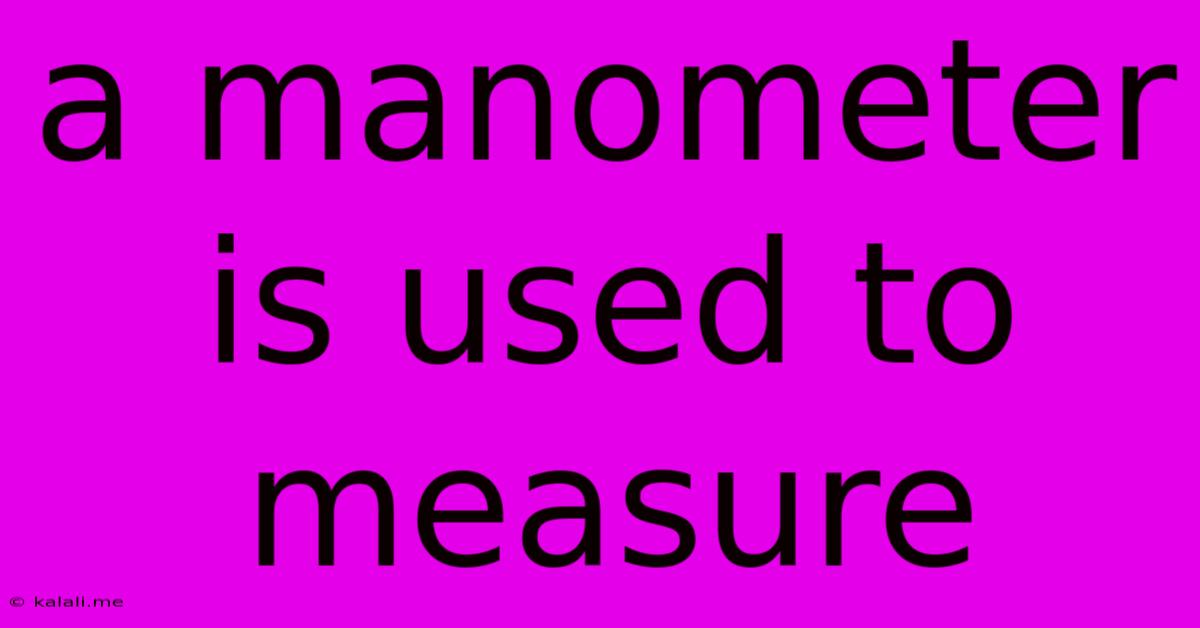A Manometer Is Used To Measure
Kalali
Jun 15, 2025 · 3 min read

Table of Contents
A Manometer: Your Guide to Pressure Measurement
A manometer is a simple yet crucial instrument used to measure pressure. Its design relies on the principles of fluid mechanics, making it a reliable tool across various scientific and engineering applications. This article delves into the different types of manometers, their applications, and how they work, providing a comprehensive understanding of this vital measurement device.
What is a Manometer and How Does it Work?
At its core, a manometer is a device that measures pressure by comparing the height difference of a liquid column in a U-shaped tube. The liquid, often mercury or water, is subjected to the pressure being measured on one side of the tube and atmospheric pressure on the other. The difference in the liquid's height directly correlates to the pressure difference between these two points. This difference is then used to calculate the absolute or gauge pressure. The principle behind this is Pascal's Law, which states that pressure applied to a fluid in a closed container is transmitted equally to every point of the fluid and to the walls of the container.
Types of Manometers
Several types of manometers exist, each suited for specific pressure ranges and applications:
- U-Tube Manometer: The simplest type, consisting of a U-shaped tube filled with a liquid. It's used for measuring relatively low pressures.
- Inclined Manometer: This manometer has one arm inclined, amplifying the height difference for more precise readings of low pressures. The inclined arm increases the sensitivity of the measurement.
- Well-Type Manometer: One arm of the U-tube is significantly larger in diameter than the other. This design allows for a smaller change in the liquid level in the larger arm, making it ideal for measuring small pressure changes.
- Differential Manometer: This type measures the pressure difference between two points. It's commonly used in applications requiring the measurement of pressure drop across a flow restriction, like a filter or valve.
Applications of Manometers
Manometers are versatile instruments with widespread use across various fields:
- HVAC Systems: Measuring pressure differences in air conditioning and refrigeration systems.
- Medical Applications: Monitoring blood pressure (though more sophisticated devices are typically used now).
- Chemical Engineering: Measuring pressures in chemical processes and reactors.
- Automotive Engineering: Testing engine components and measuring fuel pressures.
- Meteorology: Measuring atmospheric pressure (though barometers are more commonly used for this purpose).
- Hydraulic Systems: Assessing pressure in hydraulic machinery and systems.
Advantages of Using Manometers:
- Simplicity: Manometers are relatively simple in design and operation.
- Accuracy: They can provide accurate pressure measurements within their operational range.
- Cost-Effectiveness: They are generally less expensive than other pressure measurement devices.
- Direct Measurement: They provide a direct visual indication of the pressure.
Limitations of Manometers:
- Limited Range: They are typically limited to measuring relatively low pressures.
- Sensitivity to Temperature: The liquid's density can vary with temperature, affecting the accuracy of the measurement.
- Portability: Some manometers may not be easily portable.
- Susceptibility to damage: The glass tube is fragile and susceptible to breakage.
Choosing the Right Manometer
Selecting the appropriate manometer depends on the specific application and the pressure range being measured. Consider the following factors:
- Pressure Range: The manometer should be capable of measuring the expected pressure range.
- Accuracy Required: The desired accuracy of the measurement will influence the choice of manometer.
- Fluid Compatibility: The manometer fluid should be compatible with the fluid being measured.
- Environmental Conditions: The manometer should be able to withstand the environmental conditions.
In conclusion, the manometer remains a fundamental tool for pressure measurement across various disciplines. Understanding its different types and applications allows for informed selection and accurate pressure determination. While more sophisticated digital pressure gauges are frequently used today, the manometer’s simplicity and direct measurement principle ensure its continued relevance in many applications.
Latest Posts
Latest Posts
-
The Speed Of An Object In A Particular Direction
Jun 15, 2025
-
Oxidation Number Of Cr In K2cr2o7
Jun 15, 2025
-
Anything That Occupies Space And Has Mass Is Called
Jun 15, 2025
-
Line M Is Parallel To Line N
Jun 15, 2025
-
What Is Subliminal Perception In Psychology
Jun 15, 2025
Related Post
Thank you for visiting our website which covers about A Manometer Is Used To Measure . We hope the information provided has been useful to you. Feel free to contact us if you have any questions or need further assistance. See you next time and don't miss to bookmark.